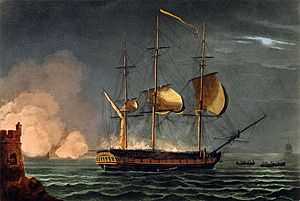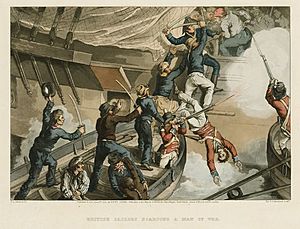HMS Hermione (1782) facts for kids

A painting showing the Santa Cecilia, which used to be HMS Hermione, being captured in Puerto Cabello by boats from Edward Hamilton's HMS Surprise in 1799.
|
|
Quick facts for kids History |
|
|---|---|
| Name | HMS Hermione |
| Ordered | 20 March 1780 |
| Builder | Sydenham Teast, Bristol |
| Laid down | June 1780 |
| Launched | 9 September 1782 |
| Commissioned |
|
| Out of service |
|
| Name | Santa Cecilia |
| Acquired | 27 September 1797 |
| Captured | By the Royal Navy on 25 October 1799 |
| Name | HMS Retaliation |
| Acquired | Captured on 25 October 1799 |
| Commissioned | September 1800 |
| Renamed | HMS Retribution on 31 January 1800 |
| Fate | Broken up in June 1805 |
| General characteristics | |
| Class and type | 32-gun Hermione-class fifth rate |
| Tons burthen | 714 70/94(bm) |
| Length |
|
| Beam | 35 ft 5+1⁄2 in (10.8 m) |
| Draught |
|
| Depth of hold | 12 ft 8 in (3.9 m) |
| Propulsion | Sails |
| Sail plan | Full-rigged ship |
| Complement | 220 |
| Armament |
|
HMS Hermione was a 32-gun frigate (a type of fast warship) in the Royal Navy. She was the first ship of her kind, known as the Hermione-class. She was built in Bristol and launched on September 9, 1782.
Hermione served in the West Indies during the early years of the French Revolutionary Wars. In 1797, Captain Hugh Pigot took command. Pigot was known for being very harsh to his crew. This led to a serious mutiny in September 1797, where Pigot and most of the ship's officers were killed. The sailors then gave the ship to the Spanish Empire, who renamed her Santa Cecilia.
However, the Royal Navy wanted their ship back! On October 25, 1799, Captain Edward Hamilton, on HMS Surprise, bravely captured Santa Cecilia from a Spanish harbor. The ship was returned to the Royal Navy and first renamed Retaliation, then Retribution in January 1800. She was eventually taken apart in June 1805.
Contents
Building and Early Service
HMS Hermione was the first of six frigates designed by Edward Hunt. She was about 39 meters (129 feet) long and 10.8 meters (35 feet) wide. Building her cost around £11,350, which was a lot of money back then! She was launched in 1782.
Hermione was first commanded by Captain Thomas Lloyd. After a few years, she was put out of service and then brought back. She had some repairs and updates between 1790 and 1793. In December 1792, Captain John Hills took command, and the ship sailed to Jamaica.
The ship played a role in the French Revolutionary Wars in the West Indies. In June 1794, under Captain Hills, Hermione helped in a British attack on Port-au-Prince. She led a small group of ships that carried soldiers. Five of her crew members were killed and six were injured in this attack. The British successfully captured the port.
Captain Hills sadly died from yellow fever in September 1794. Captain Philip Wilkinson took over, and then in February 1797, Captain Hugh Pigot became the new commander.
Captain Pigot's Command
Captain Pigot was known for being very strict and often unfair to his crew. He would give out harsh punishments. For example, on his previous ship, he ordered many floggings (a type of whipping), and some sailors were seriously harmed.
Hermione was sent to patrol the Mona Passage, a sea lane between the Dominican Republic and Puerto Rico. Under Pigot, the ship destroyed three enemy privateers (privately owned warships) near Puerto Rico in March 1797. In April, Hermione led a group of ships that captured nine other ships at the Battle of Jean-Rabel without any of her crew getting hurt.
The Mutiny on Hermione
The crew's anger towards Captain Pigot grew because of his harsh treatment. One event that really upset the crew was when a junior officer, Midshipman David Casey, was publicly humiliated. Casey was a popular officer, and Pigot ordered him to be whipped and removed from his rank, which was a very serious punishment for an officer.
Another incident happened on September 20, 1797. Pigot ordered the sailors to quickly adjust the ship's sails during a storm. He said the last men to come down from the sails would be whipped. In their rush, three young sailors fell from the rigging and died on the deck. Pigot showed no sympathy, ordering their bodies thrown overboard. He then had the other sailors who complained whipped again.
These events, along with Pigot's ongoing unfairness, pushed the crew to their breaking point.
The mutiny happened on the night of September 21, 1797. A group of sailors, possibly led by about 18 men, attacked Captain Pigot. They used knives and swords before throwing him overboard. The mutineers then went on to kill eight other officers, including the lieutenants, the marine commander, and the ship's doctor. All their bodies were thrown into the sea.
Some officers survived, including the gunner, carpenter, and the ship's master, Mr. Southcott. They were spared because they were useful for sailing the ship. Midshipman Casey was also spared. Their stories were very important later when the mutineers were brought to trial.
After the mutiny, the sailors decided to take the ship to Spanish territory. They sailed Hermione to La Guaira and handed the ship over to the Spanish authorities. The mutineers claimed they had simply set the officers adrift in a small boat, similar to what happened in the famous Mutiny on the Bounty. The Spanish paid the mutineers only a small amount of money and offered them jobs in the Spanish army or on the ship. The Spanish took Hermione into their navy and renamed her Santa Cecilia. About 25 of the former Hermione crew members stayed on the ship under Spanish guard.
Recapture and New Names

When the British Admiral Sir Hyde Parker heard about the mutiny, he was furious. He demanded the ship and the mutineers be returned. He also set up a system to find the mutineers. Eventually, 33 of them were captured. Many of them were put on trial, and 24 were hanged.
Meanwhile, Santa Cecilia was in a Spanish harbor called Puerto Cabello. On October 25, 1799, Captain Edward Hamilton, commanding HMS Surprise, led a daring mission to get her back. Hamilton and his boarding party attacked the ship in the harbor. After a very fierce fight, they managed to capture Santa Cecilia and sail her away under Spanish gunfire. The Spanish suffered many casualties, while the British had only a few injured. Captain Hamilton himself was badly wounded.
For his incredible bravery, Captain Hamilton was made a knight and received many honors. In 1847, he was awarded a gold medal for recapturing Hermione.
After being recaptured, the ship was returned to the Royal Navy. Admiral Parker first renamed her Retaliation. In late 1799 or early 1800, Retaliation captured four other ships. The British Admiralty then renamed her Retribution on January 31, 1800.
Retribution continued to serve, capturing more ships. In early 1801, she captured a Spanish schooner and an American schooner.
End of Service
Retribution arrived back in England in January 1802. She was later prepared for service with Trinity House, an organization that manages lighthouses and navigation aids. She was finally taken apart in June 1805.
Images for kids
-
A painting showing the Santa Cecilia, which used to be HMS Hermione, being captured in Puerto Cabello by boats from Edward Hamilton's HMS Surprise in 1799.
-
British sailors boarding the Hermione in Puerto Cabello by John Augustus Atkinson
See also
 In Spanish: HMS Hermione (1782) para niños
In Spanish: HMS Hermione (1782) para niños
- List of ships captured in the 19th century



